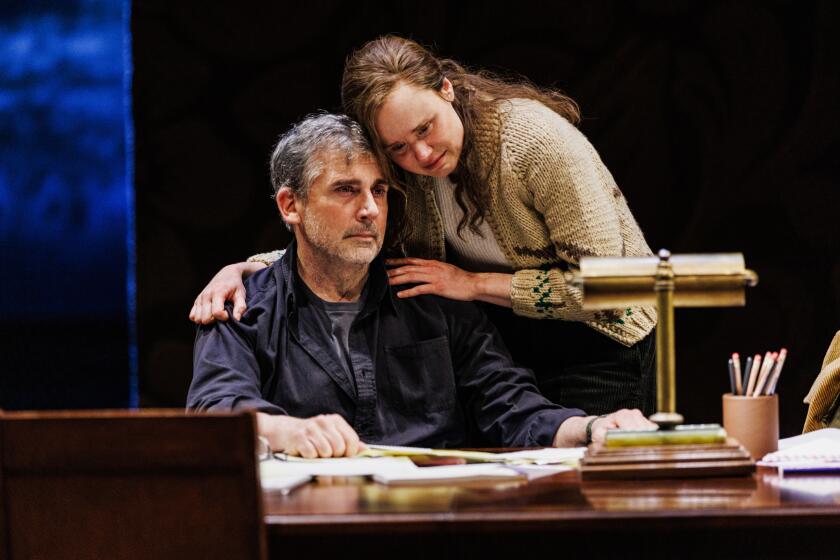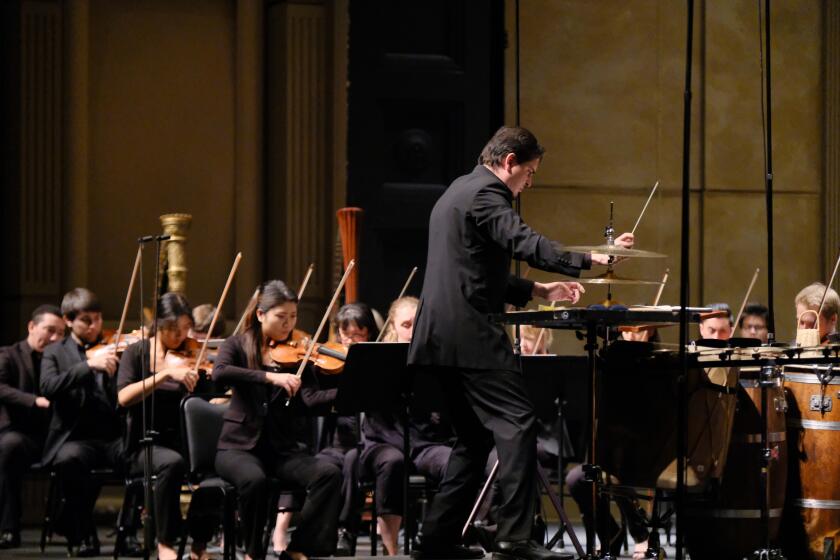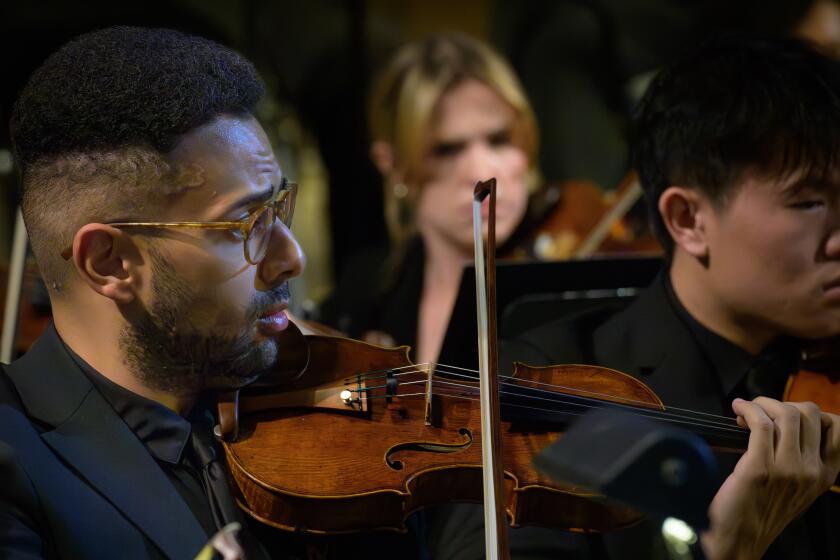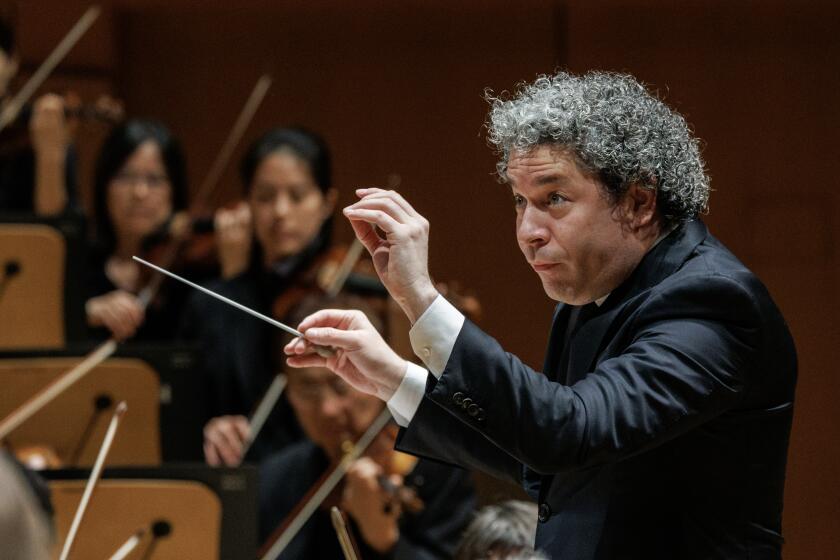Seat of Liberty Rings In New Sound
A major new performing arts center has risen in the seat of liberty, and both Philadelphia and America are better for it. With the opening ceremonies of the Kimmel Center for the Performing Arts over the weekend, this city was bursting with civic pride for its significant new commitment to the arts. But the center is a national symbol as well; 2001 will not end with only the story of destruction on the East Coast.
Broad Street, in the elegant and historic city center, is also known as the Avenue of the Arts, and the Kimmel makes it all the more so. The Kimmel, taking up a city block, but easily fitting within the scale of other buildings, , is designed by Uruguayan-born New York architect Rafael Vinoly. Its main visual draw is a dramatic, curved glass dome that encloses a galleria-like public plaza with two concert halls.
The 2,500-seat Verizon Hall is the new home that the Philadelphia Orchestra has sought almost since it began playing in the beautiful but sonically inappropriate Academy of Music in 1900. The Perelman Theater is a 650-seat chamber music auditorium. On a lower level will be a 100-seat black box theater, still under construction, for more experimental work.
The center has a complicated history. Never happy with the dry acoustics of the Academy, an opera house, the Philadelphia Orchestra first proposed building a concert hall in 1908. Finally, in 1987, it sponsored a new hall that seemed parallel to the Walt Disney Concert Hall project in Los Angeles. As in L.A., Philadelphia selected a famed local architect and had a similar initial budget.
But the orchestra failed in its fund-raising plans for the $60-million postmodern hall that Robert Venturi designed. By 1995, around the time Disney Hall almost faltered, the orchestra gave up on Venturi’s building.
Curiously, however, the city initiated a more ambitious new project. With $30 million in seed money from clothier Sidney Kimmel, the $265-million performing arts center was launched. Kimmel was permitted to select the architect, and he retained noted acoustician Russell Johnson from the original project. (Johnson will also be responsible for acoustics in the new concert hall at the Orange County Performing Arts Center).
The orchestra got its hall, but not control of it. While by far the most prominent, it is now one of six resident companies--Philly Pops, PHILADANCO, the Chamber Orchestra of Philadelphia, the Philadelphia Chamber Music Society and American Theater Arts for Youth.
Saying that he was willing to build a box but not a traditional shoe box for Verizon, Vinoly, a refined modernist who was trained as a concert pianist, noted that the cello could also be considered a box. And in fact, the hall’s sweeping, curved interior of rich dark mahogany suggests a cello’s shape.
From the downstairs seats, however, the hall also offers the not unpleasant sensation of entering a womb. It isn’t exactly a surround theater, but there is no proscenium stage, and the upper-tier seats wind around the orchestra, reaching up to the organ pipes, which are directly behind the players. (The organ has yet to be installed).
The hall is full of Russell’s acoustical bells and whistles, including doors on the sides that can open and close to change the hall’s sonic volume, and three independent wood sound reflectors that can be independently raised and lower. A computer controls everything; the acoustical ambience can change from piece to piece, although the orchestra intends to eventually find an optimal setting and keep it.
The Philadelphia Orchestra’s first test of Verizon Hall was a Saturday night gala concert, and there were problems, probably none of them insurmountable. But the orchestra’s first embarrassment occurred the night before. Kimmel told the Philadelphia Inquirer that he wanted “something a little more festive” than the Philadelphia Orchestra to open the hall. So he dug into his own pockets to hire Elton John (whose outrageous fee was $2 million for an hourlong set) as the highlight of a variety show in which Kimmel sang a duet with Paul Anka. The Philadelphia Orchestra’s program Saturday showed off both hall and orchestra so poorly that almost all comments about the acoustics need qualification. Half an hour of tedious self-congratulatory speeches made the program, which did not include an intermission, uncomfortably long (and, as one more slap in the orchestra’s face, forced it to pay the musicians overtime fees).
An air conditioner with a mind of its own created such frigid conditions that it was hard to imagine a warm sound, perhaps especially for the women in formal strapless gowns. It was worse, though, for the patron whose seat reportedly collapsed during the performance.
The orchestra performed with little time to try out the hall (its last concert at the Academy of Music was Wednesday), and the building is still not finished. The different acoustical settings will not be explored for weeks.
New risers for the stage remain to be designed. Materials must settle. What will be heard next season could be considerably different than what was heard Saturday night.
Unfortunately, the program was designed to do neither hall nor orchestra any favors. Aaron Kernis, a Philadelphia native and much-celebrated young composer, was commissioned to compose the opening work, “Color Wheel.” It is a splashy 23-minute piece meant to take advantage of a versatile virtuosic ensemble with a history of producing a colorful sound.
A listener’s ears, however, were confused. Unfamiliar music in an unfamiliar hall does not necessarily make for bewilderment, but it does when the style of the music is so evidently unfamiliar to the conductor. Wolfgang Sawallisch, the orchestra’s German music director since 1993, led a dutifully attentive performance that offered little sense of its rhythmic or sonic vitality.
The sound that reached the rear of the orchestra section of the hall was often brash, sometimes piercing, but it also hinted at appealing presence. The percussion, and there was much of it, made a thrillingly visceral impact.
The next piece, Beethoven’s Triple Concerto, was less about the orchestra’s playing that its ability to attract all-star soloists: violinist Itzhak Perlman, cellist Yo-Yo Ma, pianist Emanuel Ax. But at least Sawallisch was here more at home in his new home. Opening with rich playing from cellos and basses, one sensed that, yes, this hall may prove very satisfying. Each solo instrument was cleanly heard as well.
But in thicker textures, as with the Kernis piece, the sound could become harsh. Perhaps this will turn out to be a hall that flatters only the best players, a situation the orchestra has little to fear.
Ma, as if reacting to that, produced a full-bodied tone and became so engaged in doing so that he fell off his chair. Caught by an orchestra violinist, he continued, hardly missing a beat and turning an otherwise uneventful performance of a piece widely recognized as Beethoven’s least interesting major work into a real event.
In Ravel’s Suite No. 2, from “Daphnis and Chloe,” which concluded the program, the Fabulous Philadelphians, as the orchestra has been called, lived up to a reputation for sensational playing. The winds, shining brightly in the Verizon acoustic, offered the greatest excitement.
But sensual French music is not a Sawallisch specialty, and overall the brusque performance felt cold and glaring in its ecstatic climaxes. But by then it was so cold in the auditorium that it also felt as though the wood had turned, like the music, to ice.
That Verizon Hall, in this early state, offers glimpses of good sound should be enough to indicate that it has the potential to become a fine new home for a great orchestra. It is now up to those who run the orchestra and the center to realize this potential and to better glorify it. The orchestra deserves it.
But it is also, for Southern Californians, personal. Saturday, Johnson said that the new Costa Mesa hall will be the “brother or sister” of Verizon.
More to Read
The biggest entertainment stories
Get our big stories about Hollywood, film, television, music, arts, culture and more right in your inbox as soon as they publish.
You may occasionally receive promotional content from the Los Angeles Times.







